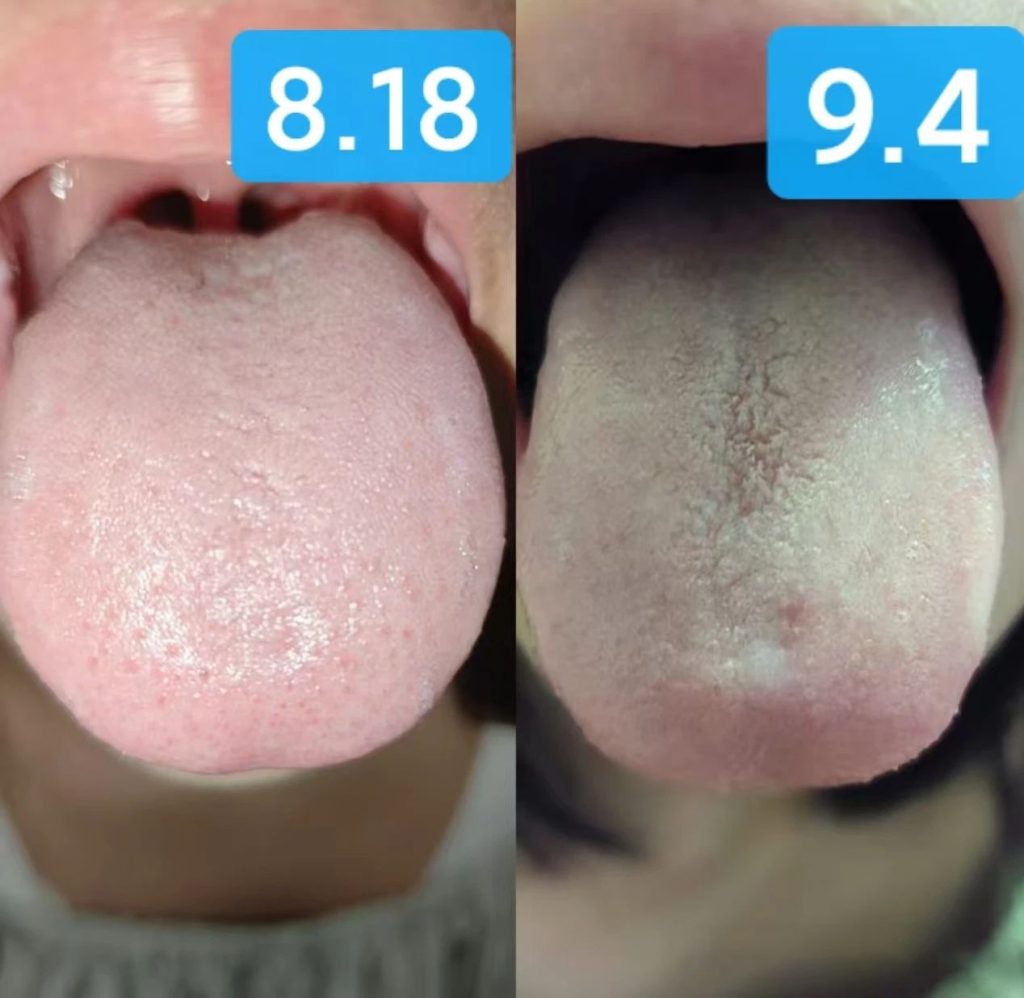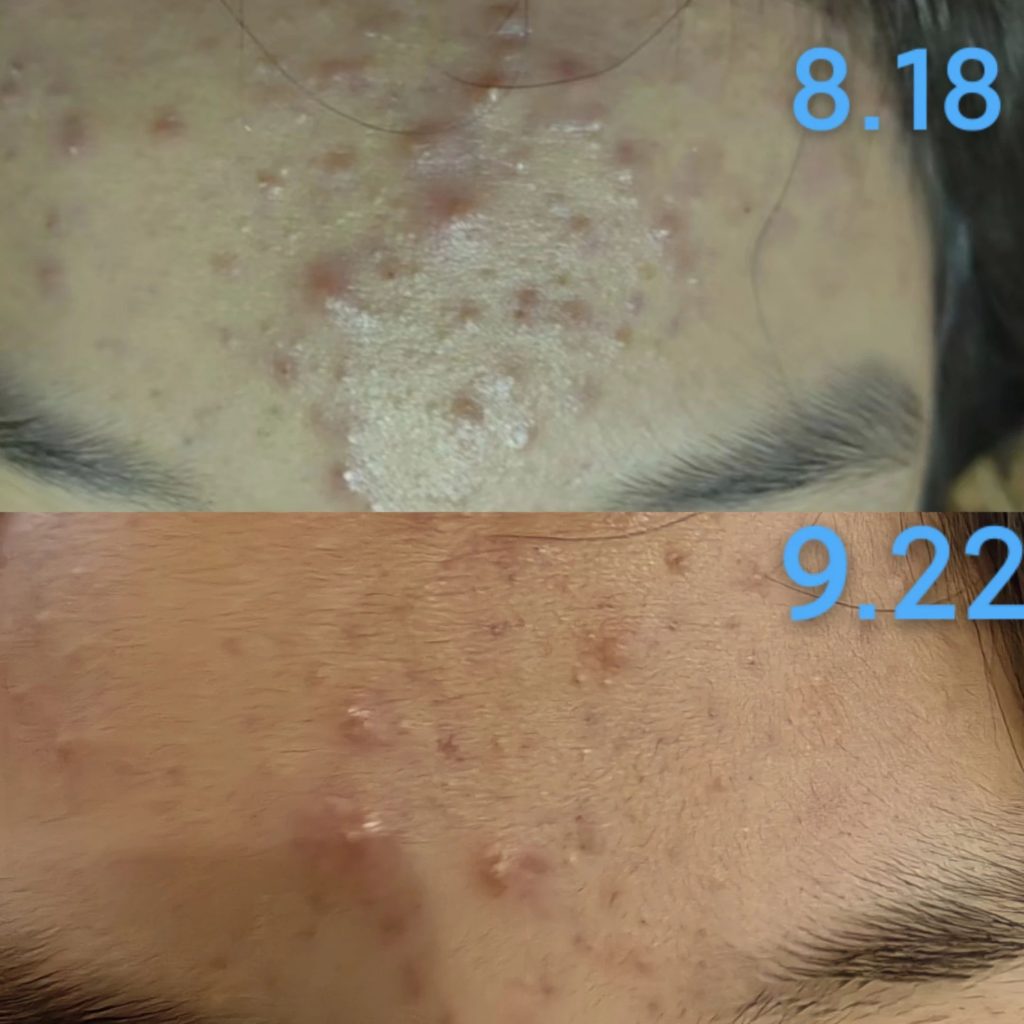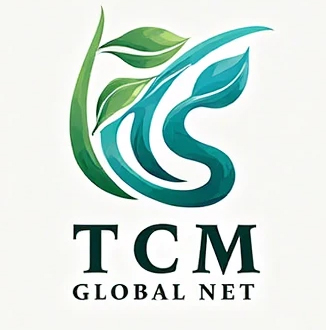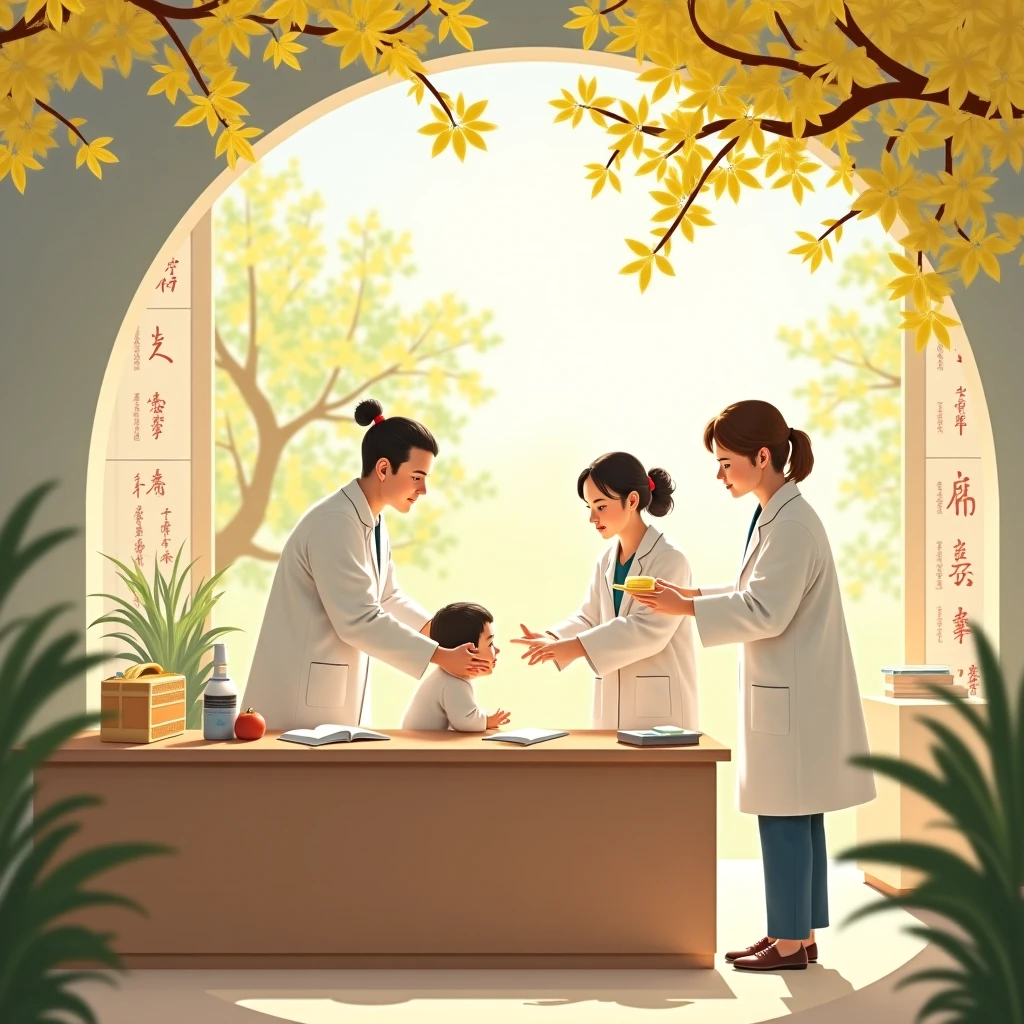1. Case Analysis: Misconceptions from “Acne” to “Acne Vulgaris”
A 12-year-old patient seen in August 2024 presented with dense conical papules on the forehead at the initial consultation, some with blackheads at the tips, accompanied by inflammatory pustules and mild itching. The parents mistakenly thought it was “normal adolescent acne,” but traditional Chinese medicine (TCM) diagnosis showed a white greasy tongue coating and a deep slippery pulse, indicating a condition of internal heat toxin combined with phlegm-dampness obstruction.
[Initial Prescription]
Bai Zhi 10g, Lian Qiao 10g, Zao Jiao Ci 10g, Pu Gong Ying 30g, Huang Qi 30g, Dang Shen 15g, Fu Chao Cang Zhu 15g, Chen Pi 15g, Gan Jiang 10g, Huang Qin 15g, Yu Jin 20g, Hei Shun Pian 10g (decocted first), Gan Cao 6g, 6 doses
Additionally, topical medication: Bai Zhi 10g, Lian Qiao 10g, Chao Jie Zi 10g, Chao Jiang Can 10g, Hong Hua 10g, powdered and mixed with white vinegar for topical application
[Analysis] Many pimples in teenagers nowadays are not normal adolescent acne but have turned into acne vulgaris. This case involves internal heat toxin combined with phlegm-dampness obstruction. Additionally, the spleen and stomach are somewhat cold.
[Comparison of Tongue Coating Before and After]
A comparison of the tongue before and after one week of medication shows that the tongue has become thinner, indicating a reduction in dampness, but the tongue coating remains white and greasy. Continued adjustment was needed, and a total of three weeks of medication was taken. However, the child’s mother did not administer the medication on time, so recovery was slower. Later follow-ups showed gradual improvement.


The child’s mother initially thought that taking the medication for 10 days would show significant results. It is common to encounter impatient patients, and it is necessary to communicate patiently when possible.
Key Differences:
| Characteristics | Normal Adolescent Acne | Acne Vulgaris |
|---|---|---|
| Cause | Simple overactive sebum secretion | Heat toxin + phlegm-dampness + liver depression + spleen deficiency combined causes |
| Lesion Morphology | Isolated whiteheads/blackheads | Multiple forms including pustules, nodules, and cysts |
| Accompanying Symptoms | No systemic discomfort | Dry mouth, bitter taste, constipation, abdominal distension, etc., indicating visceral dysfunction |
| Treatment Difficulty | Can self-heal with dietary and lifestyle adjustments | Requires systematic internal and external treatment, with a treatment course lasting several months |
TCM Pathogenesis Analysis:
The patient consumed cold foods during the summer (enjoyed cold drinks) and had high academic pressure, leading to spleen and stomach cold deficiency (pale tongue with white coating), liver depression turning into fire (irritability), and damp-heat and toxic stagnation blocking the Yangming meridian on the face, resulting in stubborn acne vulgaris.
2. Four Core Strategies for TCM Treatment of Acne Vulgaris
- Clearing Heat and Detoxifying
- Medication: Lian Qiao, Pu Gong Ying, Huang Qin (clearing lung and stomach heat toxins)
- Principle: Targets acute inflammation with red, swollen pustules; “clearing heat and detoxifying can reduce purulent lesions.”
- Promoting Toxin Expulsion and Pus Drainage
- Medication: Bai Zhi, Zao Jiao Ci (promoting pus drainage)
- Topical Application: Bai Zhi + Lian Qiao powder mixed with vinegar for topical application, enhancing local drug efficacy through skin penetration.
- Strengthening the Spleen and Resolving Phlegm
- Medication: Huang Qi, Dang Shen, Cang Zhu, Chen Pi (strengthening the middle jiao, preventing phlegm formation)
- Basis: “Spleen deficiency and excessive dampness are the root causes of recurrent acne.”
- Warming Yang and Dispelling Cold
- Medication: Hei Shun Pian (decocted first) + Gan Jiang (dispelling spleen and stomach cold deficiency)
- Diagnosis: The patient’s white greasy tongue coating indicates cold-dampness, requiring “warming yang and resolving fluids” to break the state of cold-heat stagnation.
3. Three Essential Key Understandings
- Beware of “Pseudo-Adolescent Acne”
- If pimples are markedly red, swollen, hot, and painful, and persist for over 2 months, they are likely acne vulgaris rather than common comedones, requiring prompt medical attention.
- Contraindications for Topical Medications
- Bai Zhi, Zao Jiao Ci, and other drugs with warm and pungent properties are contraindicated for use on broken skin to avoid exacerbating inflammation through irritation.
- Key Points for Treatment Course Management
- This child’s condition prolonged due to not taking medication on time; “acne vulgaris requires persistent treatment for 1-2 months.”
4. Guide to Choosing Chinese Patent Medicines
| Symptom Manifestation | Recommended Chinese Patent Medicine | Mechanism of Action |
|---|---|---|
| Local redness and swelling not subsiding | Yin Qiao Jie Du Granules | Dispelling wind and heat, alleviating acute inflammation |
| Difficulty in resolving cysts and nodules | Da Huang Zhe Chong Wan | Activating blood circulation and resolving stasis, improving microcirculation |
| Constipation exacerbating acne | Fang Feng Tong Sheng Wan | Purging heat through the bowels, resolving both exterior and interior |
| Recurrent acne during menstruation | Jia Wei Xiao Yao Wan | Soothing the liver and strengthening the spleen, regulating endocrine function |
5. Advanced Guide for TCM Enthusiasts
- Tongue Diagnosis Techniques
- Initial white greasy tongue coating → spleen encumbered by dampness
- Tongue becoming thinner after three weeks → gradual retreat of dampness, but residual heat not cleared
- Enhancing External Treatment Methods
- Bloodletting and Cupping: Bloodletting at the ear apex and back reaction points to dispel heat and detoxify
- Acupoint Embedding: Using Zusanli and Quchi points for long-term regulation of spleen and stomach function
- Dietary Restrictions List
- ❌ Milk and dairy products (increase sebum secretion)
- ❌ Fried foods (aggravate phlegm-dampness)
- ✅ Job’s tears and red bean porridge (strengthening the spleen and resolving dampness)
From a TCM perspective, normal adolescent acne and acne vulgaris have many differences. Adolescent acne does not require specific treatment, but acne vulgaris needs attention and is not just a skin issue; it requires internal adjustment.
Morphological Features
Normal Adolescent Acne: Normal adolescent acne is often caused by follicular hyperkeratosis and excessive sebum secretion. It typically appears as small papules the color of the skin or light red, ranging from the size of a millet grain to a green bean, usually isolated and not fused. The top may have white or black comedones; whiteheads are formed by the blockage of the follicular opening by keratin, while blackheads result from the oxidation of sebum.
Acne Vulgaris: Acne vulgaris is relatively more severe and complex, presenting with various forms in addition to papules, including pustules, nodules, and cysts. Pustules are formed by inflammation and pus within the hair follicle, appearing as red papules with yellow-white pustules at the top; nodules are hard lumps formed by inflammation penetrating the subcutaneous tissue; cysts are sac-like structures containing pus formed within nodules, often accompanied by pain and likely to leave scars.
Pathogenesis
Normal Adolescent Acne: Often caused by the vigorous yang energy during adolescence, or excessive consumption of spicy, fatty, and rich foods, leading to heat accumulation in the stomach and intestines, which rises along the meridians to the face, steaming the skin and causing acne. The primary affected area is the skin and superficial tissues, with relatively mild symptoms.
Acne Vulgaris: In addition to dietary factors, it is also related to emotional imbalance, phlegm-dampness, and blood stasis. Long-term emotional distress leads to liver depression and qi stagnation, which can turn into fire, or spleen deficiency causing internal phlegm-dampness, obstructing the meridians, and impeding the flow of qi and blood. Heat toxin, phlegm-dampness, and blood stasis combine on the face, resulting in acne vulgaris. The affected areas are not only the skin but also involve the liver, spleen, and other viscera, with more severe symptoms and a longer course of disease.
Accompanying Symptoms
Normal Adolescent Acne: Generally, no significant systemic symptoms, possibly only mild itching or discomfort at the local site.
Acne Vulgaris: Often accompanied by systemic symptoms such as dry mouth, bitter taste, constipation, dark yellow urine, irritability, or loss of appetite, abdominal distension, loose stools, indicating spleen deficiency and phlegm-dampness. In simple terms, if it’s normal adolescent acne, maintaining a light diet, going to bed early, and waking up early will naturally improve it. If it doesn’t improve, it indicates a bodily imbalance that needs proper adjustment. Children’s issues may not be as obvious as adults’, so early adjustment can lead to much simpler recovery. However, if the problem is already evident, in addition to adjusting daily habits, patience is required during medication, as improvement takes time.
Although the root of skin problems lies in regulating the viscera, using topical medications can significantly speed up the process.
Based on the complex causes of acne vulgaris, adjustments should be made from multiple aspects:
Approach to Treating Acne Vulgaris
Clearing Heat and Detoxifying: Lian Qiao, Pu Gong Ying, and Huang Qin have the effect of clearing heat and detoxifying, which can clear skin heat toxins and target the symptoms of local redness, swelling, heat, and pain in acne vulgaris. Lian Qiao can dispel wind-heat and resolve swelling; Pu Gong Ying is good at clearing heat and detoxifying, reducing swelling and promoting diuresis; Huang Qin can clear heat and dry dampness, purge fire and detoxify. The combined use of these three herbs can clear the accumulated heat toxins in the body and reduce the inflammatory response of acne.
Promoting Toxin Expulsion and Pus Drainage: Bai Zhi and Zao Jiao Ci can promote toxin expulsion and pus drainage, reduce swelling, and relieve pain, helping to expel the toxic pathogens within the acne and promote the resolution and healing of the lesions.
Strengthening the Spleen and Benefiting Qi: Huang Qi, Dang Shen, Fu Chao Cang Zhu, Chen Pi, and Gan Jiang work together to strengthen the spleen, benefit qi, dry dampness, and resolve phlegm. The spleen and stomach are the foundation of acquired constitution; normal spleen and stomach function ensures the source of qi and blood production and proper water-dampness metabolism. Regulating spleen and stomach function fundamentally improves the underlying cause of acne vulgaris.
Warming Yang and Dispelling Cold: Hei Shun Pian, when decocted first, can warm and supplement kidney yang, dispel cold, and relieve pain, helping to improve the constitution of yang deficiency and cold stagnation, promoting the circulation of qi and blood, and allowing the medicinal effects to reach the entire body more effectively.
Soothing the Liver and Regulating Qi: Yu Jin has the effect of soothing the liver, regulating qi, activating blood, and resolving stasis, which can adjust emotions, alleviate liver depression and qi stagnation, promote smooth qi flow, and benefit the treatment of acne vulgaris.
Topical Medications
Bai Zhi and Lian Qiao clear heat and detoxify, reduce swelling and relieve pain; Chao Jie Zi warms and unblocks the meridians, resolves phlegm and disperses nodules; Chao Jiang Can dispels wind, resolves phlegm, disperses nodules, and unblocks the meridians; Hong Hua activates blood and resolves stasis, improving local blood circulation. Mixing these with white vinegar for topical application allows the drugs to better penetrate the skin, directly acting on the acne area, enhancing the effects of clearing heat and detoxifying, reducing swelling and dispersing nodules, and activating blood and resolving stasis.


Leave a Reply